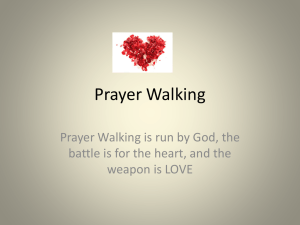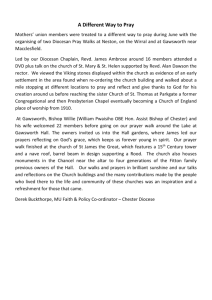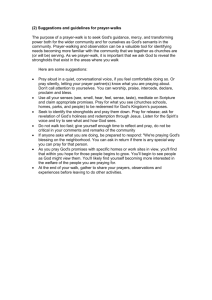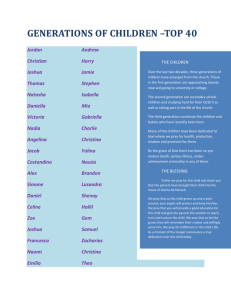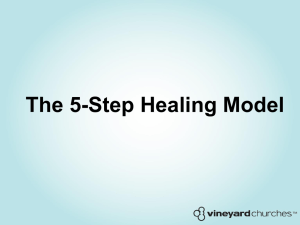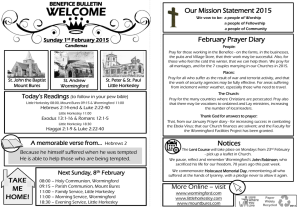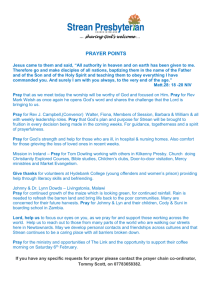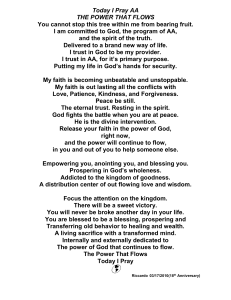GUIDE TO PRAYER-WALKING IN THE COMMUNITY
advertisement
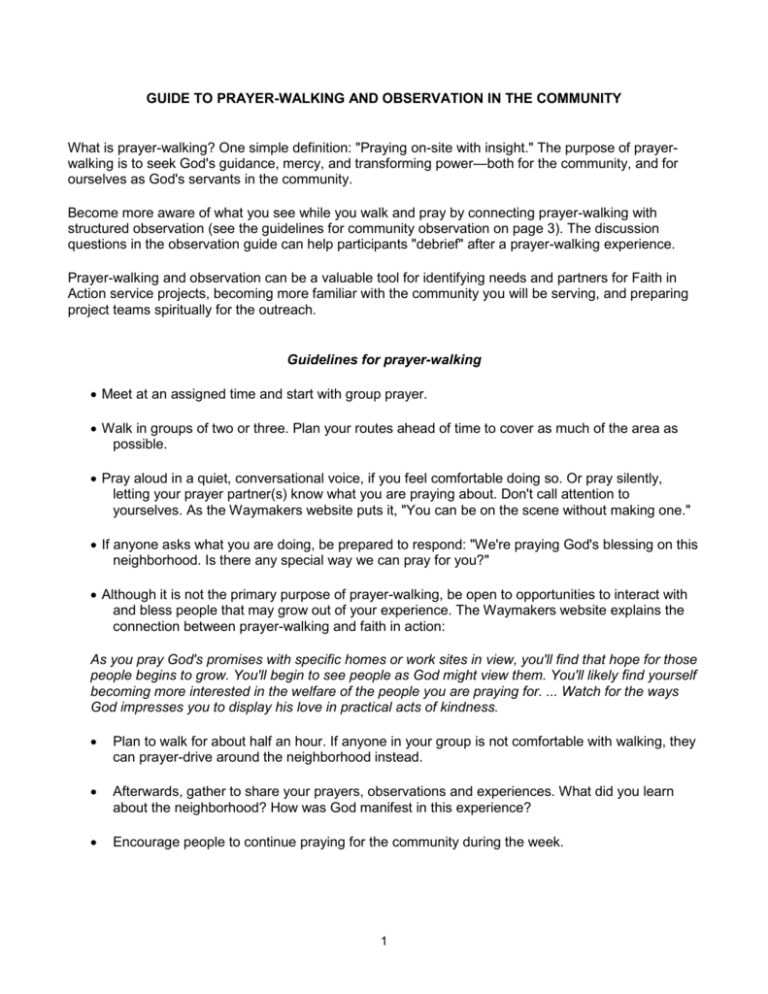
GUIDE TO PRAYER-WALKING AND OBSERVATION IN THE COMMUNITY What is prayer-walking? One simple definition: "Praying on-site with insight." The purpose of prayerwalking is to seek God's guidance, mercy, and transforming power—both for the community, and for ourselves as God's servants in the community. Become more aware of what you see while you walk and pray by connecting prayer-walking with structured observation (see the guidelines for community observation on page 3). The discussion questions in the observation guide can help participants "debrief" after a prayer-walking experience. Prayer-walking and observation can be a valuable tool for identifying needs and partners for Faith in Action service projects, becoming more familiar with the community you will be serving, and preparing project teams spiritually for the outreach. Guidelines for prayer-walking Meet at an assigned time and start with group prayer. Walk in groups of two or three. Plan your routes ahead of time to cover as much of the area as possible. Pray aloud in a quiet, conversational voice, if you feel comfortable doing so. Or pray silently, letting your prayer partner(s) know what you are praying about. Don't call attention to yourselves. As the Waymakers website puts it, "You can be on the scene without making one." If anyone asks what you are doing, be prepared to respond: "We're praying God's blessing on this neighborhood. Is there any special way we can pray for you?" Although it is not the primary purpose of prayer-walking, be open to opportunities to interact with and bless people that may grow out of your experience. The Waymakers website explains the connection between prayer-walking and faith in action: As you pray God's promises with specific homes or work sites in view, you'll find that hope for those people begins to grow. You'll begin to see people as God might view them. You'll likely find yourself becoming more interested in the welfare of the people you are praying for. ... Watch for the ways God impresses you to display his love in practical acts of kindness. Plan to walk for about half an hour. If anyone in your group is not comfortable with walking, they can prayer-drive around the neighborhood instead. Afterwards, gather to share your prayers, observations and experiences. What did you learn about the neighborhood? How was God manifest in this experience? Encourage people to continue praying for the community during the week. 1 How do you pray? Here are some pointers: Pray for discernment -- Seek the gift of seeing the community through Christ's "lens," and to discern what God is already doing there; ask God to show you how you can pray with greater insight for the people, events, and places in the community. Pray for blessing – Pray over every person, home and business you encounter; for God's intervention in each life, so that each one can be fruitful in God's kingdom; for God's will to be done in this community "as it is in heaven" (Matt. 6:10). Pray with empathy -- See and feel what residents live with every day; offer intercession for those things that express brokenness and grieve God's spirit, and give thanks to God for the blessings and gifts that exist in the community. Pray from Scripture -- Prayers based directly on God's word can be especially powerful. You may want to bring a Bible with key passages highlighted, or copy verses onto note cards. Pray in God's power -- allow times of silence for God's spirit to speak to you, or through you (Romans 8:26). Ask with confidence in the power of Jesus' name (John 14:12-14). Like the disciples sent out by Christ, we are empowered to push back the darkness (Luke 10:17-18). (Read more about prayer-walking and download detailed guides at www.waymakers.org/prayerwalking.html; also see Jay Van Groningen, Communities First [CRWRC, 2005], pages 30-31) 2 Guidelines for community observation Even if you have been in a community for a long time, you can learn to see the familiar with new eyes, alert to indicators of need as well as signs of God's reign. Walk through as much of the community as you are able; if the area is far-flung, or if the weather is bad, a driving ("windshield") survey is another option. If possible, ask a resident to give you a guided tour of the neighborhood. Open your observation time by asking God to allow you to see with his eyes of love and discernment. You can combine observation with more in-depth prayer for the community and/or with a neighborhood survey (see the sample survey on the Faith in Action resource CD). Consider completing this exercise more than once, with a different focus for your observations and prayers each time. Use the categories on the next page to organize your observations. Respect the dignity of community members by recording your notes as unobtrusively as possible. Be present as servants, not tourists! After the visit, take time as a group to compare notes and reflect on your observations. Discuss the following: What positive qualities, opportunities and benefits does the community have to offer? What are signs that God is already at work in the neighborhood? Identify potential partners (people, churches, organizations) that the church could come alongside in serving the community. What needs and concerns are in evidence? What do you see that might detract from people's quality of life or hinder people from developing their potential? What challenges are people likely to face as they go about their daily life? How might community residents view your congregation? Would you be perceived as allies, foreigners, friends, helpers, annoyances, or simply irrelevant? Take note of your own response to what you see. What kinds of "vibes" do you get from your encounters in the community? What feels familiar or strange? Safe or dangerous? Friendly or hostile? Happy or sad? Pleasant or uncomfortable? Do you sense any barriers to "fitting in" between yourself and the community—language, culture, class, ethnicity, age? What stereotypes about people and places might you have to address to build healthy relationships with people here? How is the Good News of salvation through Christ relevant here? What might it look like if God's kingdom were realized "on earth as it is in heaven" here in this community? Imagine how your congregation, working alongside members of the community, might participate in helping the neighborhood experience God's design for a good life. Did your prayerful observations spark any ideas for your Faith in Action project or ongoing ministry in this community? Identify how you could follow up with organizations or individuals in the community. Close with a time of prayer for the neighborhood and for your congregation's witness and service there. 3 Community Observation Guide Look for evidence of the following: People groups: Who is standing at bus stops, hanging out on street corners, going into businesses, playing in the park, waiting in line at the store? Note ages, ethnicities, languages, and apparent economic status. How much do you see people interacting with one another? Places of activity: A pizza joint crowded with youth, a shopping plaza, a heavily trafficked intersection, playgrounds, school zones Structures: What are the types and conditions of the structures (homes, businesses, roads, parks)? How much "free space" is there in the community? What is the mix of private and public space? Services: Where can people go to shop, eat out, get an education, worship, and receive assistance? What appears to be the quantity and quality of available services? Who is providing services, and who is receiving them? Signs of change: Note which businesses are opening or closing, and if housing is under construction, for sale, or being demolished. Check for languages added to shop signs, and buildings used in ways different from their original purpose. Overall, do conditions appear to be getting better or worse? Signs of hope: Where is there evidence of God's grace and God's people at work? Look for churches and nonprofit organizations, playing children, uplifting artwork, Christian symbols, social gatherings, and gardens. Look especially for local assets that could be connected with neighborhood needs. Signs of need: Look for evidence of hardship, hurt or injustice. Is what you see specific to particular areas or affecting the neighborhood as a whole? Be aware that marginalized people and social problems are often hidden, especially in communities that appear well-off. People groups Places of activity Structures Services Signs of change Signs of hope Adapted with permission from Community Study Guide: Understand Your Church's Context for Ministry by Heidi Unruh (2007), www.fastennetwork.org. 4 Signs of need
